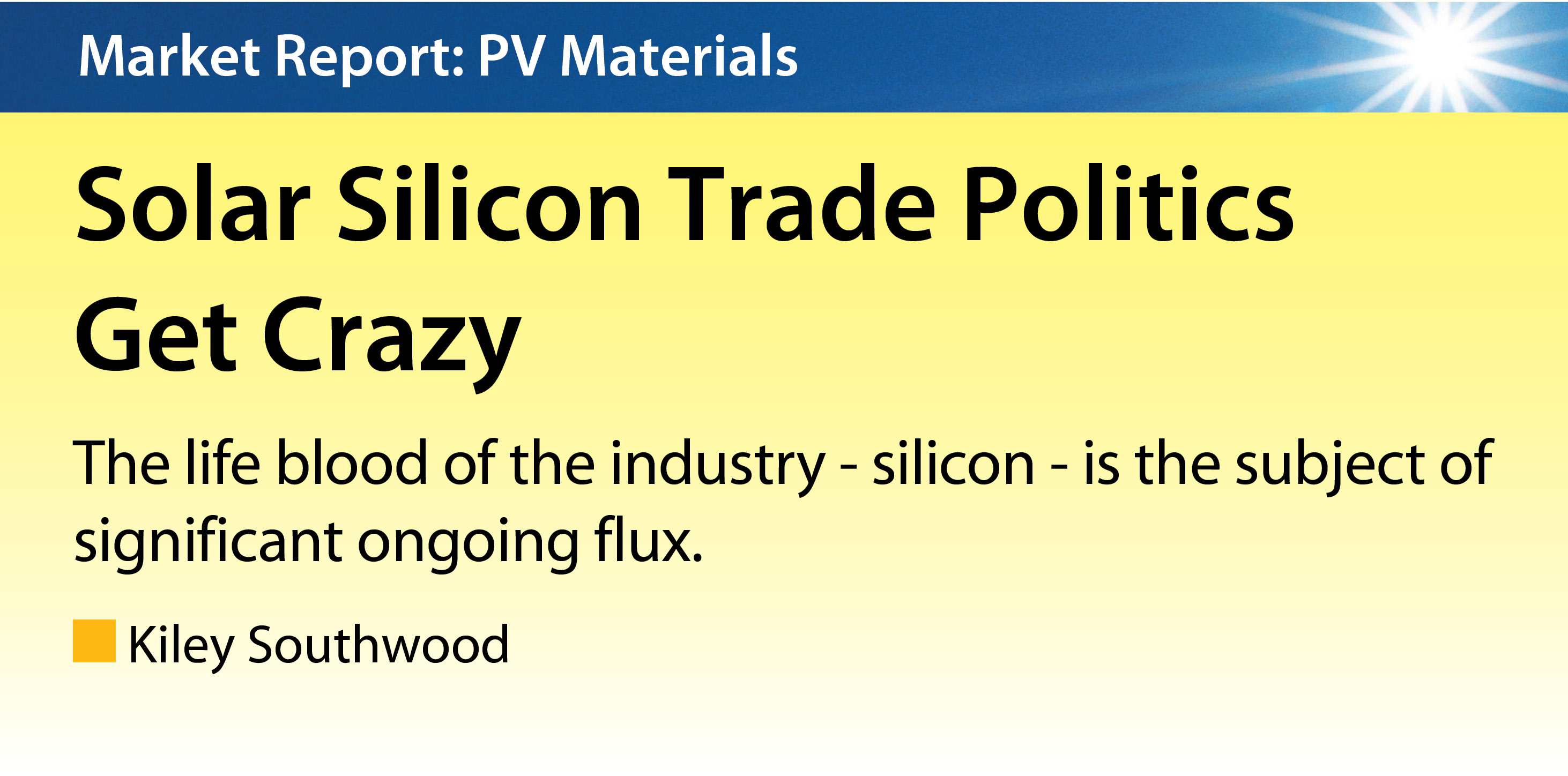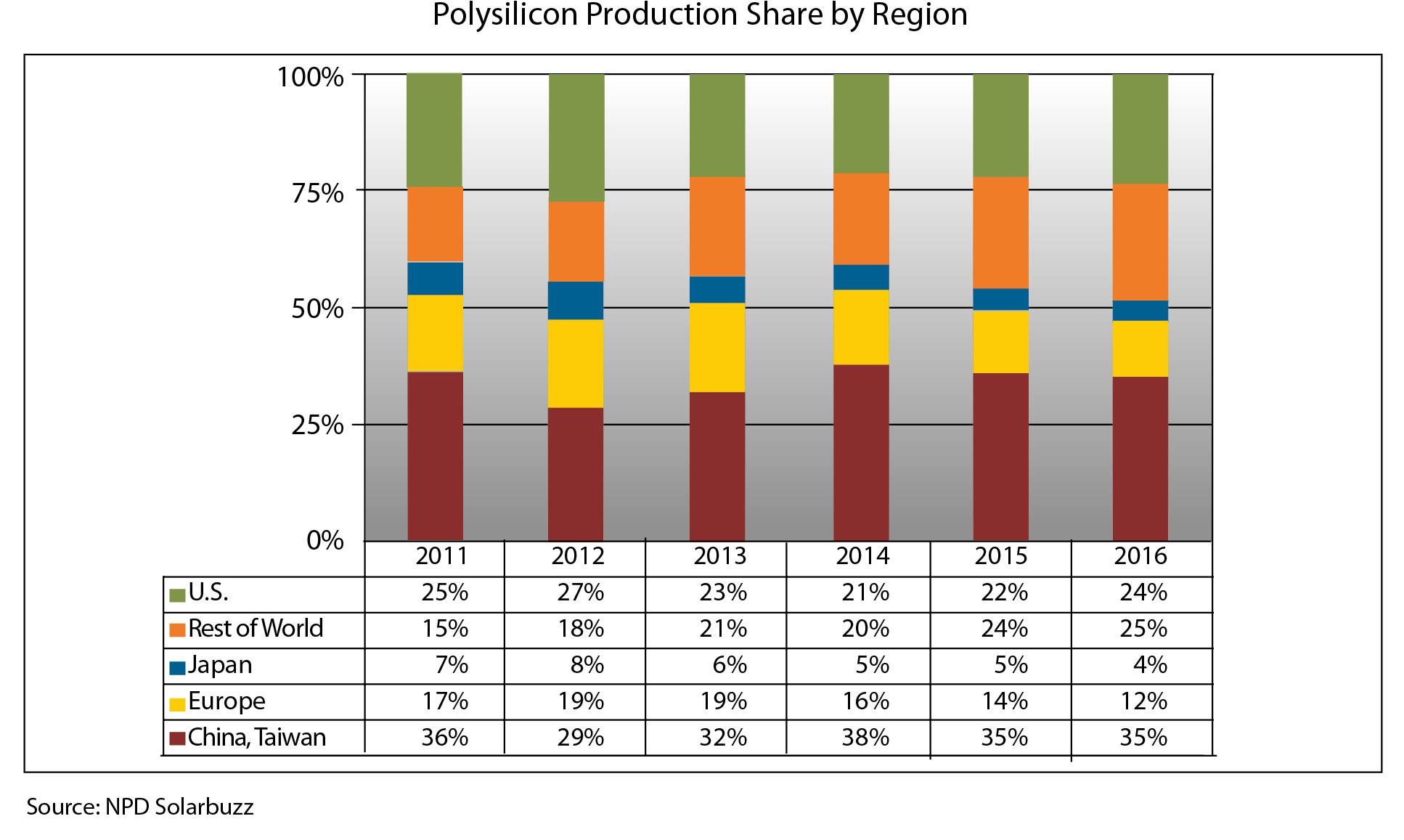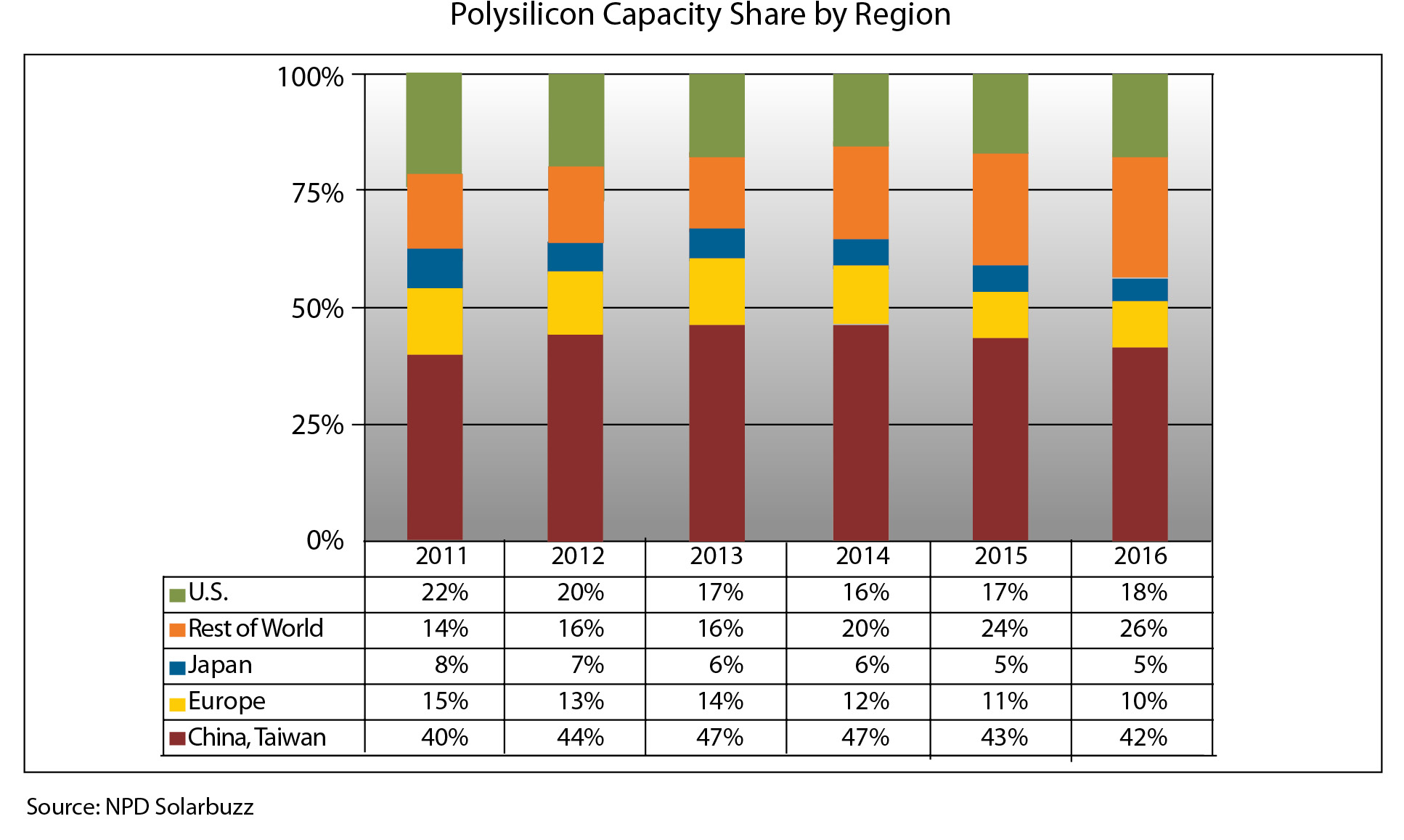

301 Moved Permanently
When SolarWorld and its partners in the Coalition for American Solar Manufacturing launched an anti-dumping complaint and countervailing-duty petition against China in October 2011, detractors immediately warned that the action would lead to retaliation and a protracted global trade war.
Since SolarWorld’s initial complaint (which resulted in tariffs on Chinese modules), new coalitions from Europe to India have jumped into the fray, aiming to protect their own exports. Most recently, China struck back: In mid-July, China’s Ministry of Commerce (MOFCOM) announced duties - ranging from 2.4% to 57% - on solar-grade polysilicon from the U.S. and South Korea.
These latest tariffs add another stressor and layer of uncertainty to an already-challenged solar supply chain, especially in the silicon segment. Solar silicon producers that have managed to avoid complete shutdown face production suspensions, stubbornly low selling prices and a bleak forecast of continued overcapacity.
Most industry experts agree that the days of high polysilicon prices and even supply shortages - a dominant trend in the solar manufacturing industry just a few years ago - will not return and that China’s latest volley in the global solar trade war may only inflict further damage.
MOFCOM imposed the highest tariffs (57%) on two U.S.-headquartered subsidiaries of REC Group - REC Solar Grade Silicon LLC and REC Advanced Silicon Materials LLC - and AE Polysilicon Corp. U.S.-based Hemlock Semiconductor and MEMC were hit with a slightly lower 53.7% rate. (All other U.S. companies not specifically named in the announcement face the top rate of 57%.)
Duties for South Korean silicon manufacturers top out at 48.7% for KAM Corp. and Innovations Silicon Co. However, Johannes Bernreuter, founder and head of Germany-based market research firm Bernreuter Research, believes that in the current solar silicon production landscape, OCI Co. Ltd. is the only South Korean company to still play a significant role. He considers its assigned 2.4% tariff strictly symbolic.
Meanwhile, solar silicon trade politics also continue to play out in Europe. Although Germany’s economic minister recently made a public comment stating that no tariffs would be imposed on polysilicon exported from European Union (EU) countries, as of press time, China’s MOFCOM had not yet made a final announcement.
“It is very political at this point,” says Charles Annis, vice president at market research firm NPD Solarbuzz. “It was expected that China would tie poly import tariffs to European import tariffs on modules.”
As the European Commission continues negotiations with China on minimum prices for wafers, cells and modules, MOFCOM has repeatedly postponed its decision on EU polysilicon duties, making the dependency clear, Bernreuter adds. If EU polysilicon does eventually receive tariffs, he expects the rates to be lower than those assigned to U.S. and South Korean exports.
Pricing effects
Like many other non-Chinese solar silicon producers, Germany-based Wacker Polysilicon (a division of Wacker Chemie AG) forecasts that punitive tariffs could constrain broader solar market growth and impair solar energy’s ability to compete globally with other energy sources.
“In the last months, Wacker has clearly taken a position against any trade barriers and explained the detrimental effects to policymakers in Munich, Berlin, Brussels and Beijing,” says Ewald Schindlbeck, president of Wacker Polysilicon. “History has shown that any intervention, be it political or regulatory, has never helped protect industries or companies from market developments.”
EU ProSun, the European coalition that initiated solar module trade complaints against China last year, has weighed in even more strongly, attacking China’s tariffs on polysilicon from the U.S. and South Korea as “Mafia behavior from the Middle Kingdom.”
“China’s behavior and the ongoing violations of international trade law show that the People’s Republic is no real trading partner,” said Milan Nitzchke, president of EU ProSun, in a statement following MOFCOM’s announcement. “Rather, it is a permanent showdown where China continuously breaks the law and threatens and punishes those who take legitimate action against such practices.”
Politicized rhetoric aside, however, many industry analysts expect even the steepest tariffs on U.S. manufacturers to create a relatively weak pricing shift.
“The impact of polysilicon tariffs on the global market will be negative but limited,” says Stefan de Haan, principal analyst at IHS - Solar Research, citing statistics from the company’s PV Price Tracker - Polysilicon. “We don’t expect poly prices in China to increase by more than 10 to 15 percent.”
Although some Chinese manufacturers with idled polysilicon factories had announced plans to resume operations pending tariff implementation, they will likely find little relief under the “new” market conditions, according to Bernreuter. He predicts that they may see spot prices rise from approximately $16.50/kg to $19.50/kg at most - an insufficient increase to keep most tier-two manufacturers in business.
“I doubt that the high expectations they have for the impact of duties, namely strongly rising prices, will be fulfilled,” Bernreuter says.
One key reason for the diluted financial effect is the tariffs’ limited application. “These duties will not be imposed on material that is used for solar modules to be exported but only on polysilicon imports for the domestic market,” he notes.
Furthermore, China’s delays earlier this year in introducing the tariffs caused the market to respond prematurely. Each time the MOFCOM announcement was anticipated - first in February and then in April - average spot prices increased by approximately $3.00/kg, Bernreuter says. Each time the announcement failed to appear, prices dropped back to nearly their previous levels, blunting the impact when MOFCOM finally came out with its announcement.
Even a significant spike in spot pricing for solar silicon would have limited impact, as approximately 70% of the material in the solar marketplace is sold under long-term supply agreements, de Haan says. Despite paying a higher average contract price (approximately $21.00/kg in June), manufacturers remain protected from pricing volatility.
Overcoming overcapacity
Noting increasingly stable module prices and improving manufacturer margins, some recent industry reports call for a positive turnaround among solar module suppliers as early as this year. However, their counterparts upstream in the supply chain will likely take significantly longer to return to health.
“Overcapacity is still the dominating issue, and it will last longer than for any other nodes of the solar supply chain,” says de Haan. “We don’t expect a healthy supply-demand balance before 2015 or 2016.”
“We are not expecting a significant recovery in poly for three-plus years,” Annis agrees. “The [trade action] unfortunately may just prolong this, helping some marginal Chinese players to remain in the market longer. Most Chinese makers have already stopped production. We think only a few will restart, and most of the lower-tier makers will be forced to exit.”
Although the polysilicon tariffs may prevent a module price slide during the second half of the year, any short-term recovery for Chinese polysilicon manufacturing will be limited, de Haan agrees. Certain companies, particularly GCL-Poly Energy Holdings, may see a short-term benefit, but U.S. manufacturers facing tariffs will likely find export loopholes.
Despite the dire outlook for China’s silicon manufacturers, the country’s role in solar silicon production is expected to remain essentially the same. China and the U.S. each produce approximately 30% of the global solar polysilicon supply, de Haan says. Europe follows closely behind, with 25% of the global supply, and South Korea currently produces 15%. (See the figures.)
The U.S.’ share could fall slightly in the wake of the tariffs, but the general landscape will remain in place for the foreseeable future, according to de Haan.




New possibilities
The U.S. recently lost one long-struggling polysilicon player, demonstrating the global reach of the polysilicon market’s woes. Hoku Corp., which faced problems ranging from unpaid loans to a dispute with the local utility over its fab’s electricity usage as it struggled to begin production in Pocatello, Idaho, filed for bankruptcy in June.
Industry experts disagree on whether Hoku’s troubles primarily stemmed from company-specific shortcomings or general industry challenges.
“First and foremost, Hoku’s failure was homemade,” Bernreuter says. “It did not have a clear strategy on funding or technology procurement, which delayed the project again and again. The price decay due to oversupply finished the company off.”
Annis, on the other hand, points out that even leading polysilicon producers are currently in the red, and Hoku’s main misfortunes - capacity-based oversupply, prices below their assumed target price at the start of the project and a lack of economies of scale - were hardly unique.
Over the past few years, the rapid price erosion - a drop of 65% year over year in 2011 and an additional drop of 39% year over year in 2012 - has proved too steep for manufacturers that lacked the cost basis of tier-one manufacturers such as Wacker and Hemlock, de Haan says.
Finally, in the midst of such turmoil, could alternatives to conventionally produced high-end polysilicon creep further into the market? IHS notes in a recent report that Chinese cell manufacturers can counteract any price increases for high-grade polysilicon from the EU, the U.S. and South Korea by blending it with lower-quality silicon.
IHS’ de Haan describes this approach as presently widespread, but he predicts that recent concerns about module quality and more pressure on higher efficiencies will increase demand for purer 9N silicon (i.e., silicon qualified 99.99999+ percent pure).
Wacker’s Schindlbeck reports consistent customer demand for high-end material. “High-quality polysilicon maximizes yields, reduces waste and, thus, makes cell and module manufacturing cost-efficient,” he says.
Upgraded metallurgical-grade (UMG) silicon, which was once heralded as a cost-cutting savior for the PV manufacturing industry, has largely fallen off the map, Bernreuter says. Prospective customers of UMG supplier Silicor Materials Inc., however, have responded favorably to test samples, indicating a possible future return of UMG.
In contrast, fluidized bed reactor (FBR) technology, an alternative to the popular Siemens process, has raised its profile in the past few years. “The cost reductions this technology promises are much more likely to be achieved in mass production at sufficient quality now,” de Haan predicts.
SMP - a joint venture between SunEdison and South Korea-based Samsung Fine Materials - plans to begin silicon production later this year using FBR technology to produce granular polysilicon from monosilane.
This technology could ultimately help encourage broader market acceptance of high-efficiency monocrystalline cells, Bernreuter says. S
Market Report: PV Materials
Solar Silicon Trade Politics Get Crazy
By Kiley Southwood
The life blood of the industry - silicon - is the subject of significant ongoing flux.
si body si body i si body bi si body b
si depbio
- si bullets
si sh
si subhead
pullquote
si first graph
si sh no rule
si last graph